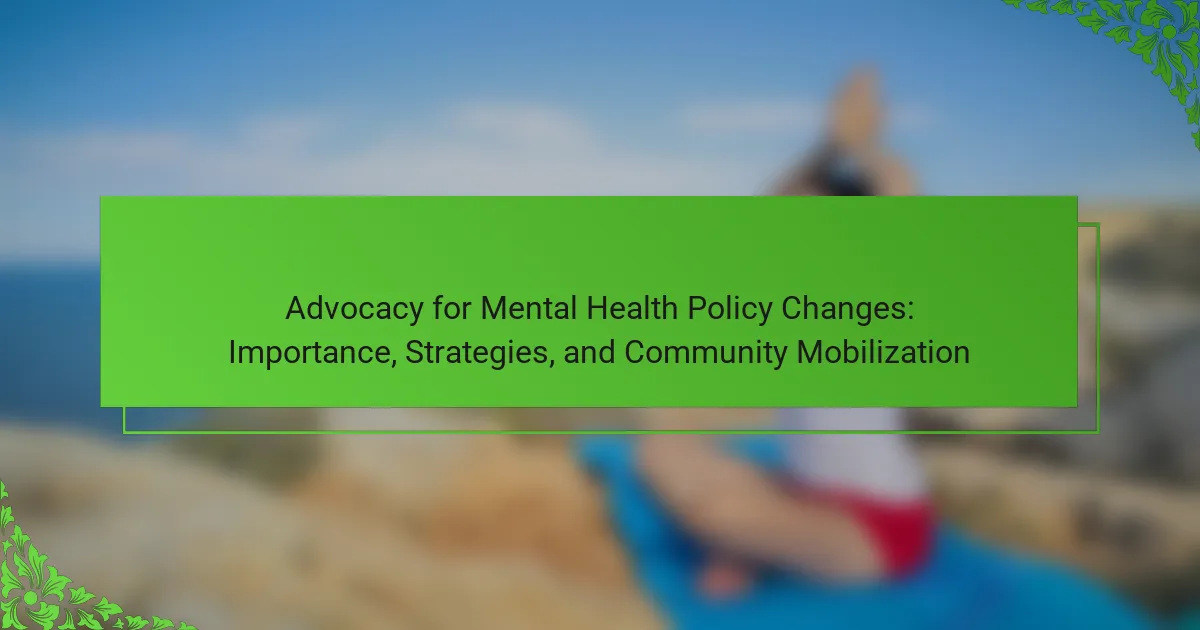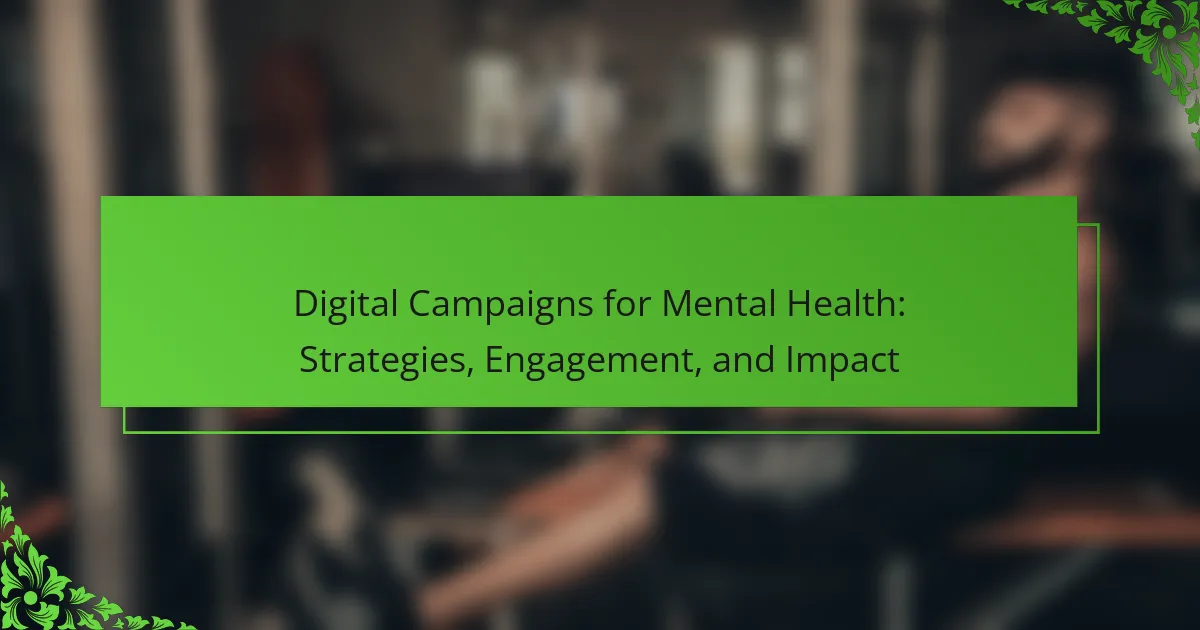Advocacy for mental health policy changes is essential for improving access to care and driving systemic improvements. The article explores effective strategies such as coalition building and grassroots mobilization, highlights the importance of community engagement, and addresses challenges like stigma and funding limitations. Innovative approaches, including storytelling and peer-led initiatives, are examined to enhance advocacy outcomes.
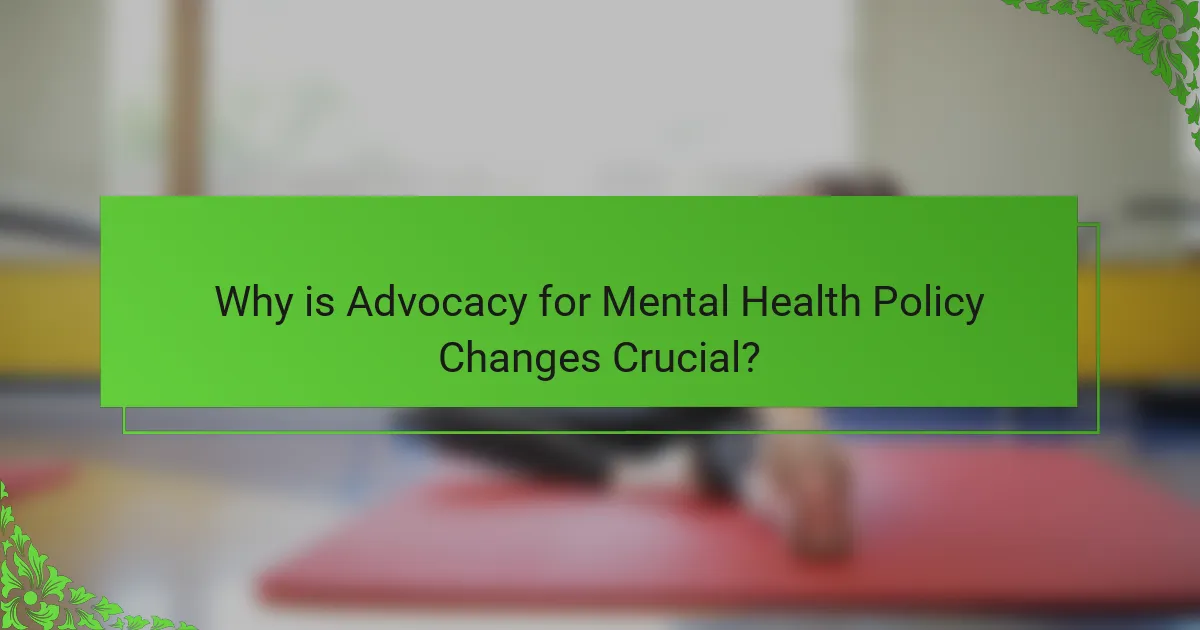
Why is Advocacy for Mental Health Policy Changes Crucial?
Advocacy for mental health policy changes is crucial because it drives systemic improvements and increases access to care. Effective advocacy raises awareness, influences legislation, and empowers communities. According to the National Alliance on Mental Illness, approximately 1 in 5 adults experience mental illness, highlighting the need for robust policy support. Mobilizing communities fosters collaboration, ensuring diverse voices are heard, which can lead to comprehensive and inclusive mental health strategies.
What are the key benefits of mental health policy advocacy?
Advocacy for mental health policy changes leads to improved access to services, reduced stigma, and increased funding. These benefits enhance overall community well-being and support effective treatment options. Advocacy empowers individuals and organizations to influence policy decisions, fostering a more inclusive approach to mental health. As a result, communities become more resilient and responsive to mental health needs.
How does mental health policy impact community well-being?
Mental health policy significantly enhances community well-being by promoting access to care, reducing stigma, and fostering supportive environments. Effective policies lead to better mental health outcomes and increased community resilience. Advocacy efforts focus on raising awareness, mobilizing resources, and influencing legislative changes. Community engagement is crucial for implementing these policies, as it ensures that diverse needs are addressed and that mental health services are accessible to all.
Which statistics highlight the urgency of mental health reforms?
Statistics reveal a critical need for mental health reforms. Approximately 1 in 5 adults experience mental illness annually, yet only 43% receive treatment. Suicide rates have increased by 33% since 1999, emphasizing the urgency for policy changes. Additionally, mental health disorders cost the global economy an estimated $1 trillion each year in lost productivity. These figures highlight the necessity for effective advocacy and community mobilization to drive meaningful policy changes.

What Strategies are Effective for Advocating Mental Health Policy Changes?
Effective strategies for advocating mental health policy changes include coalition building, grassroots mobilization, and leveraging data-driven narratives. Engaging stakeholders ensures diverse perspectives are represented. Utilizing social media amplifies messages and fosters community support. Evidence-based advocacy demonstrates the urgency for policy reform, influencing decision-makers effectively.
How can grassroots movements influence policy decisions?
Grassroots movements can significantly influence policy decisions by mobilizing community support and raising awareness. They create pressure on policymakers through organized campaigns, public demonstrations, and strategic partnerships. These movements often highlight mental health issues, advocating for necessary changes and funding. Their success relies on community engagement and the ability to present compelling data that resonates with the public and legislators.
What role do mental health professionals play in advocacy?
Mental health professionals play a crucial role in advocacy by influencing policy changes and raising awareness. They provide expert insights that shape mental health legislation, ensuring that policies reflect the needs of individuals and communities. Through community mobilization, they engage stakeholders and promote mental health awareness, fostering a supportive environment. Their unique understanding of mental health issues enables them to advocate effectively for equitable access to services and resources.
Which communication tactics resonate with policymakers?
Direct communication tactics that resonate with policymakers include data-driven messaging, personal stories, and clear calls to action. These strategies effectively convey the urgency of mental health policy changes.
Data-driven messaging provides evidence of mental health issues’ impact, making a compelling case for action. Personal stories humanize the statistics, illustrating real-life consequences and fostering empathy. Clear calls to action guide policymakers on specific steps they can take to address mental health challenges.
Engaging with policymakers through tailored communications enhances the likelihood of positive responses. Building relationships through regular updates and collaborative opportunities can further strengthen advocacy efforts.

How Can Communities Mobilize for Mental Health Advocacy?
Communities can mobilize for mental health advocacy by fostering awareness, building coalitions, and engaging local leaders. These strategies enhance outreach and promote policy changes. For example, organizing workshops can educate the public about mental health issues, while collaborating with local organizations can amplify voices and resources. Engaging community members through storytelling creates personal connections that drive advocacy efforts. Finally, leveraging social media platforms can broaden the reach of advocacy campaigns, ensuring mental health remains a priority in local policies.
What are the best practices for community engagement in advocacy?
Effective community engagement in advocacy involves building relationships, fostering participation, and promoting awareness. Key practices include organizing community forums to discuss mental health issues, utilizing social media for outreach, collaborating with local organizations, and training advocates to empower individuals. These strategies enhance awareness and mobilize community support for mental health policy changes.
How can social media amplify advocacy efforts?
Social media amplifies advocacy efforts by increasing visibility, fostering community engagement, and facilitating information sharing. Platforms enable advocates to reach wider audiences, mobilize supporters, and create impactful campaigns. For example, hashtags can unify voices around mental health issues, driving awareness and action. Additionally, social media allows for real-time communication, enabling advocates to respond promptly to policy changes and public sentiment. This immediacy enhances the effectiveness of advocacy strategies, ensuring that mental health policy discussions remain relevant and dynamic.
Which organizations are leading community mobilization for mental health?
Organizations leading community mobilization for mental health include the National Alliance on Mental Illness (NAMI), Mental Health America (MHA), and the World Health Organization (WHO). These entities advocate for policy changes, raise awareness, and mobilize communities. NAMI focuses on grassroots support and education, MHA emphasizes prevention and early intervention, while WHO provides global leadership and guidance on mental health initiatives. Their collaborative efforts enhance mental health advocacy and support systems.

What Challenges do Advocates Face in Mental Health Policy Changes?
Advocates for mental health policy changes face significant challenges that hinder progress. These include limited funding, political resistance, stigma surrounding mental health, and fragmentation within the advocacy community. Limited funding restricts resources for effective campaigns. Political resistance often arises from differing priorities and lack of understanding. Stigma perpetuates misconceptions, making it harder to gain public and political support. Fragmentation leads to disjointed efforts, reducing overall impact. Addressing these challenges requires strategic collaboration and sustained community mobilization.
How do funding limitations affect advocacy efforts?
Funding limitations significantly hinder advocacy efforts for mental health policy changes. Insufficient resources restrict outreach, limit campaign effectiveness, and reduce community engagement. Advocacy groups struggle to mobilize support, conduct research, and influence policymakers without adequate funding. As a result, mental health initiatives may lack visibility and urgency, impeding progress.
What resistance do advocates encounter from policymakers?
Advocates encounter resistance from policymakers primarily due to budget constraints, competing priorities, and lack of awareness about mental health issues. Policymakers often prioritize immediate economic concerns over long-term mental health benefits. Additionally, stigma surrounding mental health can lead to reluctance in addressing these policies. Advocates must navigate these challenges through strategic communication and building coalitions to highlight the importance of mental health initiatives.
Which misconceptions hinder mental health advocacy?
Misconceptions such as stigma, misinformation, and the belief that mental health issues are not serious hinder mental health advocacy. Stigma leads to discrimination, preventing individuals from seeking help. Misinformation creates barriers to understanding mental health, while the perception that mental health is less important than physical health diminishes advocacy efforts. Addressing these misconceptions is crucial for effective policy changes and community mobilization.
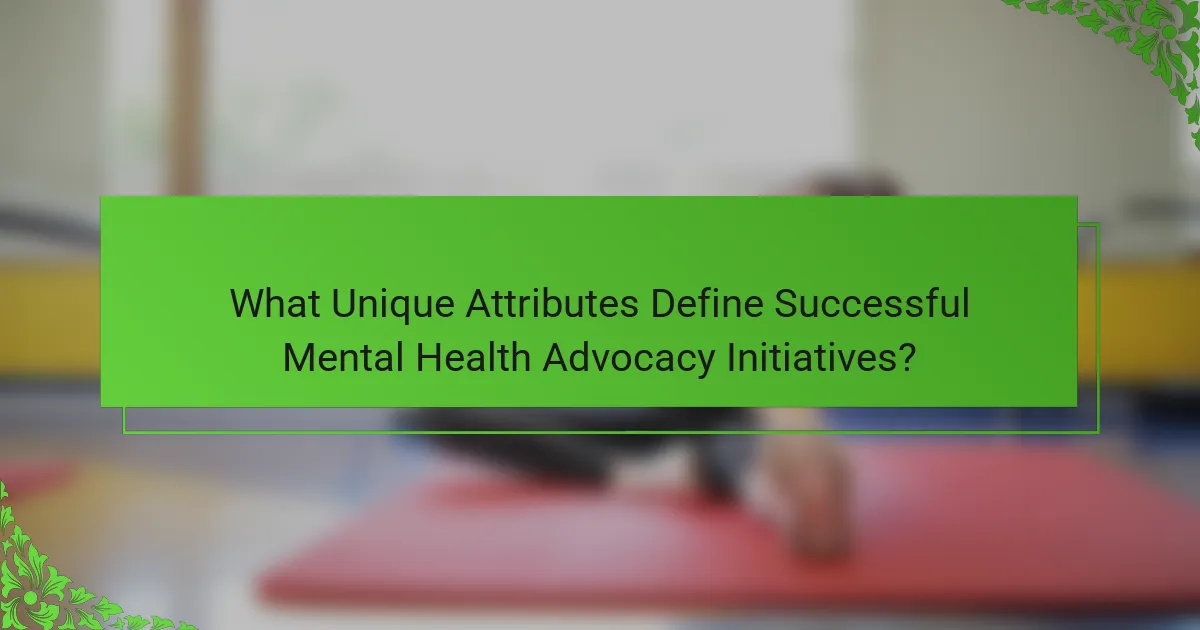
What Unique Attributes Define Successful Mental Health Advocacy Initiatives?
Successful mental health advocacy initiatives are defined by unique attributes such as community engagement, evidence-based strategies, and inclusivity. Community engagement fosters trust and participation, ensuring that diverse voices are heard. Evidence-based strategies enhance credibility and effectiveness, leading to more impactful policy changes. Inclusivity ensures that marginalized groups are represented, promoting equity in mental health access and support. These attributes collectively strengthen the initiative’s ability to drive meaningful change in mental health policy.
How do cultural factors influence advocacy strategies?
Cultural factors significantly shape advocacy strategies for mental health policy changes. They influence messaging, community engagement, and coalition-building efforts.
For example, cultural beliefs about mental health impact stigma levels, which can either hinder or facilitate advocacy efforts. Understanding these cultural nuances allows advocates to tailor their approaches effectively, ensuring greater resonance with diverse communities.
Additionally, cultural contexts dictate the preferred methods of communication and mobilization. Some cultures may favor direct engagement through community events, while others might respond better to digital campaigns.
Incorporating cultural insights into advocacy strategies enhances their relevance and effectiveness, ultimately driving more meaningful policy changes.
What innovative approaches have emerged in recent years?
Innovative approaches in mental health advocacy focus on community engagement, technology integration, and policy collaboration. Recent strategies emphasize grassroots mobilization, leveraging social media for awareness, and utilizing data analytics to drive policy changes. These methods enhance community participation and ensure that diverse voices are heard in mental health policy discussions.
Which success stories can inspire future advocacy efforts?
Success stories from various advocacy efforts can significantly inspire future mental health policy changes. For instance, the National Alliance on Mental Illness successfully campaigned for the Mental Health Parity and Addiction Equity Act, which mandated equal insurance coverage for mental health and physical health services. Similarly, the Mental Health Advocacy Coalition in the UK effectively mobilized community support to influence the implementation of the Five Year Forward View for Mental Health, leading to increased funding for mental health services. These examples highlight the power of grassroots movements and strategic partnerships in driving impactful policy changes.
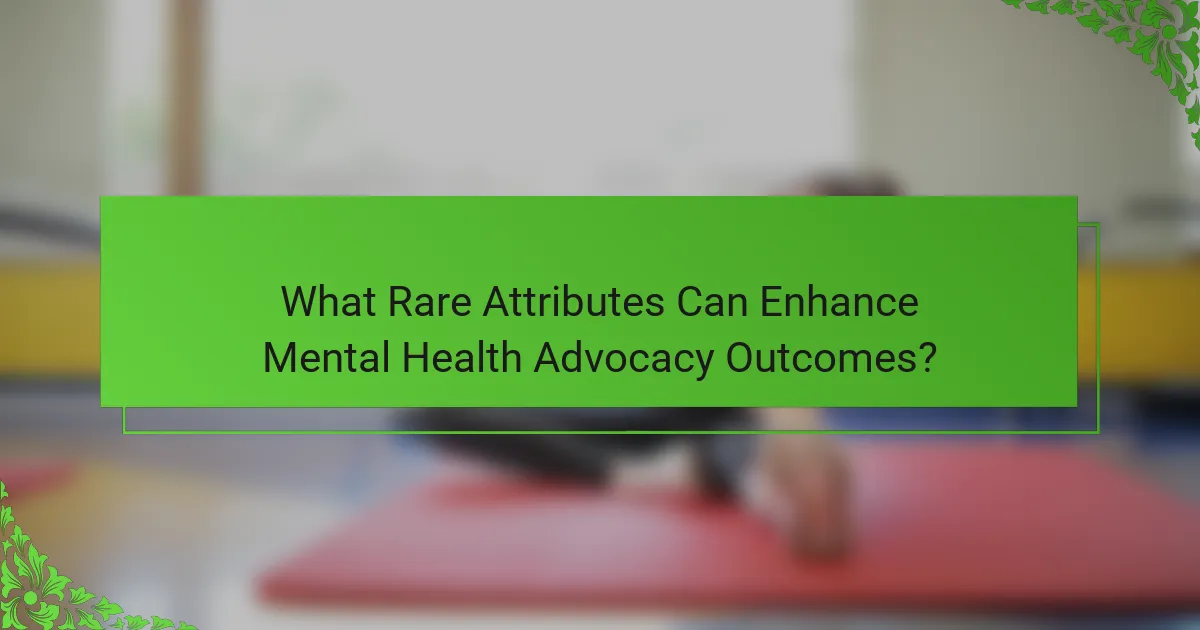
What Rare Attributes Can Enhance Mental Health Advocacy Outcomes?
Innovative approaches can enhance mental health advocacy outcomes by incorporating unique attributes such as storytelling, peer-led initiatives, and culturally tailored messaging. Storytelling fosters emotional connections, making complex issues relatable. Peer-led initiatives empower individuals with lived experience, enhancing credibility and engagement. Culturally tailored messaging addresses specific community needs, increasing relevance and impact. These rare attributes can drive effective policy changes and mobilize community support.
How can interdisciplinary collaboration strengthen advocacy?
Interdisciplinary collaboration strengthens advocacy by integrating diverse expertise, enhancing the effectiveness of mental health policy changes. This collaboration fosters innovative strategies that address complex issues, mobilizing communities more efficiently. By uniting professionals from various fields, advocacy efforts gain broader perspectives, leading to comprehensive solutions. For example, partnerships between mental health professionals, educators, and policymakers can create more impactful campaigns, ensuring that mental health policies reflect the needs of the community.
What role does technology play in modern advocacy efforts?
Technology plays a crucial role in modern advocacy for mental health policy changes by enhancing communication and mobilization efforts. Digital platforms enable advocates to reach larger audiences and facilitate discussions. Social media campaigns raise awareness and foster community engagement. Data analytics tools help identify trends and measure impact, guiding strategic decisions. Additionally, online petitions and crowdfunding platforms empower grassroots movements, ensuring diverse voices contribute to policy dialogues.
How can unexpected partnerships lead to impactful changes?
Unexpected partnerships can drive impactful changes in mental health advocacy by combining diverse resources and perspectives. Collaborative efforts between organizations, community leaders, and policymakers can amplify voices and enhance visibility. For instance, partnerships between mental health organizations and educational institutions can lead to innovative programs that address youth mental health needs. These collaborations can create comprehensive strategies that mobilize communities, ensuring broader support for policy changes. Ultimately, such alliances foster a shared commitment to improving mental health outcomes and influence legislative action effectively.
What are the common pitfalls in mental health advocacy?
Common pitfalls in mental health advocacy include lack of awareness, inadequate messaging, and insufficient community engagement. Advocates often underestimate the complexity of mental health issues, leading to oversimplified narratives. Additionally, failure to collaborate with diverse stakeholders can hinder effective policy changes. Misalignment between advocacy goals and community needs can also result in disengagement. Lastly, neglecting to measure the impact of advocacy efforts may prevent the identification of successful strategies.
Which expert tips can improve advocacy effectiveness?
To improve advocacy effectiveness for mental health policy changes, focus on building strong community partnerships. Collaborate with local organizations to amplify voices and share resources. Utilize data to support arguments, demonstrating the impact of mental health issues. Develop clear, actionable messages that resonate with diverse audiences. Engage stakeholders through consistent communication and active participation in discussions.
